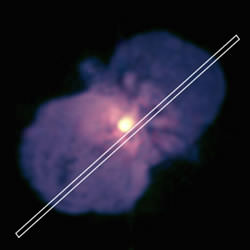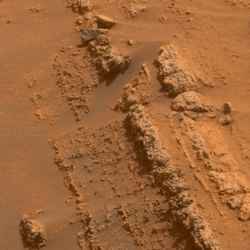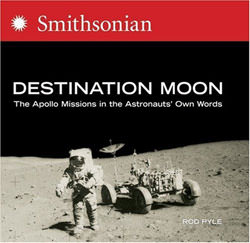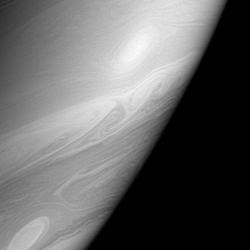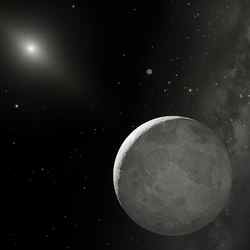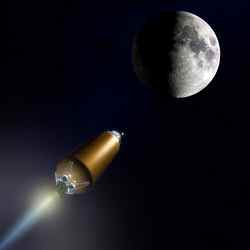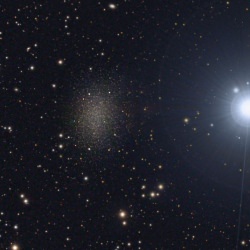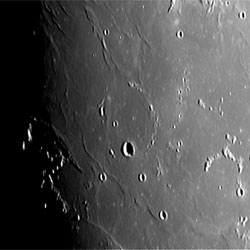
Class I Flamsteed. Image credit: Ricardo Borba. Click to enlarge.
Greetings, fellow SkyWatchers! This week will be filled with meteor showers and moon shine – bright nebula and galaxies. The “Ring King” Saturn is now at its best, so get out under the stars, because…
Here’s what’s up!
Monday, April 10 – Be sure to get up before dawn to enjoy the Virginid meteor shower. The radiant point will be near Gamma in the bowl of Virgo. The fall rate of 20 per hour is above average for meteor showers, and with the Moon out of the equation this morning, you’re in for a treat!
Tonight we’ll start by identifying the large mare just south of central on the lunar disc called Oceanus Procellarum. Look almost centrally within its grey expanse for a large crater which has mostly melted down. This “ghost crater” has no name, but look along its edge for Class I Flamsteed. It is very near here that Surveyor 1 still stands. It made its landing on June 2, 1966 and sent back more than 11,000 pictures of the rock strewn, desert-like floor. This area was one of the first chosen for an Apollo mission landing, but was later scratched for a more central location.
Now let’s move on to 3.2 magnitude Mebsuta – Epsilon Geminorum. Mebsuta is the brightest star (other than Castor) in northwestern Gemini. It has a very distant 9th magnitude companion. As you observe Epsilon, keep in mind its spectral class (G8) is very similar to our Sun. Despite this, Mebsuta glows with an intensity of light 7600 times brighter. It’s one of a rare class of stars called “yellow supergiants” – stars whose nuclear cores are vastly swollen due to advanced age and which have taken on “planetary” proportions. Why planetary? Because the planet Venus would find itself orbiting inside Mebsuta’s 4600 degree C temperature photosphere!
Tuesday, April 11 – Today is the birthday of William Wallace Campbell. Born in 1862, Campbell went on to become the leader of stellar motion and radial velocity studies. He was the director of Lick Observatory from 1901 to 1930, and also served as president of the University of California and the National Academy of Sciences. Also born on this day – but in 1901 – was Donald H. Menzel – assistant astronomer at Lick Observatory. Menzel became Director of Harvard Observatory, an expert on the Sun’s coronosphere and held a genuine belief in the extraterrestrial nature of UFOs. Today in 1960, the first radio search for extraterrestrial civilizations was started by Frank Drake (Project Ozma). In 1986, Halley’s Comet closed within 65 million kilometers of the Earth ? as close as it would get.
If you would like to try out a pair of less obvious lunar features, start out again tonight at Oceanus Procellarum – a vast, grey “sea” encompassing most of the northwestern portion of the Moon. On the terminator to its southwest (and almost due west geographically), you will see two craters nearly identical in size and depth. The southern crater is Billy – one of the darkest floored areas on the Moon. Inside Billy’s bright rim, you will notice an interior as featureless as a mare. North of Billy is Hansteen, whose interior is much brighter and shows complex details. Comparing the two will show Billy was once filled with smooth lava, while Hansteen avoided that fate and shows its native scarred interior.
Although skies will be bright this evening, we can still have a look at brilliant Arcturus – a star whose distance from the Earth (10 parsecs) and radial velocity (less than 200 meters per second) can almost be considered a benchmark. By skydark you will see 0.2 magnitude Arcturus – the brightest star in Bootes and 4th brightest star in the night sky – some 30 degrees above the eastern horizon. Apparent to the eye is Arcturus’ orange color. Because a star’s intrinsic luminosity relates to its apparent brightness and distance, Arcturus’ absolute magnitude is almost precisely the same as its apparent magnitude. Just because Arcturus’ radial velocity is nearly zero doesn’t mean it isn’t on the move relative to our Sun. Arcturus star is now almost as close as it will ever get and its large proper motion – perpendicular to our line of sight – exceeds 125 kilometers per second. Every 100 years Arcturus moves almost 1 degree across the sky!
Wednesday, April 12 – Today in 1961, Yuri Gagarin made one full orbit of the Earth aboard Vostok 1, while also becoming the first human in space. Also today (in 1981) Columbia became the first Space Shuttle to launch.
Tonight let’s launch our lunar explorations as we head for the far north for an “on the edge” feature – Pythagoras. Named for the Greek philosopher and mathematician, you will see this smooth, walled plain as a thin, bright ellipse standing out well against the background of northern Sinus Iridum. Pythagoras is one of the deepest craters in the northern quadrant and would be even more spectacular if visible from overhead – rather than at an angle. Look for its tall and prominent central peak.
Although the Moon will interfere with most studies, we can still check out Iota Cancri – a fine wide disparate double of magnitudes 4.0 and 6.6 separated by some 30 arc seconds. This true binary is so distant from one another that they take over 60,000 years to complete a single orbit around their common center of gravity! Located slightly less than a fist’s width due north of M44, this pair is about 300 light years distant. Both stars shine with a light considerably brighter than our Sun and observers may note a subtle gold and pale blue color contrast between them.
Thursday, April 13 – Tonight’s Full Moon is often referred to as the “Pink Moon” of April. As strange as the name may sound, it actually comes from the herb moss pink- or wild ground phlox. April is the time of blossoming and the “pink” is one of the earliest widespread flowers of the spring season. As you might expect, this Full Moon is also known by other names as well. How about the “Full Sprouting Grass Moon,” the “Egg Moon,” or the coastal tribe based “Full Fish Moon” as we’ve entered the season when fish swim upstream to spawn.
Tonight let’s take a journey towards the 25th brightest star in the night sky – 1.3 magnitude Regulus. Regulus, known as “The Little King,” is the brightest star in Leo. At 77 light-years away, this star is considered a “dwarf” despite shining with a visible light almost 150 times that of Sol. The orange-red giant Arcturus and the blue white “dwarf” Regulus both share a common absolute magnitude very close to 0. The reason the two stars shine with a similar intrinsic brightness – despite widely different physical sizes – is Regulus’ photosphere is more than twice as hot (12,000 C) as Arcturus. While observing Regulus, look for a distant companion of magnitude 8.5. Normally low powers would best concentrate the companion’s light, but try a variety of magnifications to help improve contrast. For those with large aperture scopes, look for a 13.1 magnitude “companion’s companion” a little more than 2 arc seconds away!
Friday, April 14 – Today is the birthday of Christian Huygens. Born in 1629, the Dutch scientist went on to become one of the leaders in his field during the 17th century. Among his achievements were promoting the wave theory of light, patenting the pendulum clock, and improving the optics of telescopes by inventing a new type eyepiece and reducing false color through increasing the focal length of refractor telescopes. Huygens was the first to discover Saturn’s rings and largest satellite – Titan. Of the rings, Huygens said, “Saturn: encircled by a ring, thin and flat, nowhere touching, and inclined to the ecliptic.”
To honor Huygen’s achievements and get a sense just how “on the edge” his observations were at the time, consider the fact Huygens used a home built instrument of 12 foot (336.7) focal length and little more than 2 inches in aperture (57mm). Tonight, why not have a low power look at Saturn using your smallest scope. At what magnification does it become clear to you that the planet has “lost its ears” and gained a ring?
Saturday, April 15 – Tonight keep a watch for the “April Fireballs.” This unusual name has been given to what may be a branch of the complex Virginid stream which began earlier in the week. The absolute radiant of the stream is unclear, but most of its long tails will point back toward southeastern skies. These bright bolides can possibly arrive in a flurry – depending on how much Jupiter’s gravity has perturbed the meteoroid stream. Even if you only see one tonight, keep a watch in the days ahead. The time for “April Fireballs” lasts for two weeks. Just seeing one of these brilliant streaks will put a smile on your face!
While thinking of Jupiter, why not search for the planet’s ghost? The “Ghost of Jupiter” sits after skydark in the constellation Hydra. Start at Alpha Hydrae and head east about a fist’s width to find Lambda within a field of nearby fainter stars. Continue less than a fist southeast and locate Mu. You’ll find the “Ghost of Jupiter” (NGC 3242) lurking in the dark less than a finger-width due south. At magnitude 9, the NGC 3242 gives a strikingly blue-green appearance in even small scopes – despite being more than 1500 light years away.
Before we call it a night, let’s visit with Luna as we look along the southern shore of Mare Humorum and identify ancient crater Vitello. Notice how this delicate ring resembles earlier study Gassendi on the opposite shore.
Sunday, April 16 – With the later rise of the Moon, this is a fine opportunity to have a look at a group of galaxies between Leo’s paws. Start at Regulus and look due east toward Iota Leonis. Halfway between the two (less than a fist from Regulus) and two finger-widths northeast of Rho Leonis, you’ll encounter Messier Galaxies M95 and M96 – both within the same low power field of view. At magnitude 9.2, the brighter – and slightly rounder – M96 lies northeast of 9.7 magnitude M95. Pierre M?chain discovered both galaxies on March 20, 1781 and Messier added them to his catalog 4 days later. These two galaxies are two of the brightest members of the Leo I galaxy group located some 38 million light-years away.
To see another Messier member of the Leo I group, center on M96 and shift the galaxy south. From the north side of the low power field, the 9.3 magnitude galaxy M105, nearby 10th magnitude NGC 3384, and 12th magnitude NGC 3389 will come into view. M105 was discovered by M?chain on the night Messier catalogued M95 and 96 but was not formally added to Messier’s catalog. Based on M?chain’s observing notes, Helen Sawyer Hogg added it to Messier’s list in 1947 – along with galaxy M106 and globular cluster M107. M?chain failed to notice M105’s bright neighboring galaxy – NGC 3384. NGC 3384 is actually slightly brighter than the faintest Messier discovered – M91.
We’re not done yet! If you center on M105 and shift due north less than a degree and a half you will encounter 10th magnitude NGC 3377 – a small elongated galaxy with a stellar core. There are a dozen galaxies visible to moderate amateur instruments (through magnitude 12) in the Leo I region of the sky!
If you are out late enough to study the Moon, relocate previous study Petavius on the southern terminator. Just beyond its east wall, look for a bright ridge that extends from north to south separated by darkness from Petavius. This is Palitzsch, a very strange, gorge-like formation that looks as if it was caused by a meteor plowing through the Moon’s surface. Palitzsch’s true nature wasn’t known until 1954 when Patrick Moore resolved it as a “crater chain” using the 25″ Newall refractor at Cambridge University Observatory.
May all your journeys be at light speed… ~Tammy Plotner with Jeff Barbour.
